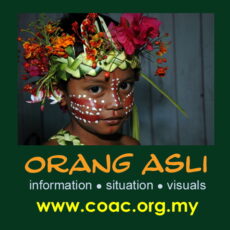The communal baths and toilets that were built alongside the construction of the balai adat (community centre of custom) at Kampung Pian in Kuala Krau, Pahang last year has been awarded the Gold Prize in the Special Category of the 2014 PAM Awards. PAM is the Malaysian Institute of Architects and the awards are given for ‘Excellence in Architecture’.
Designed and conceptualized by Ang Wen Hsia of WHBC Architects, the project incorporated modern architectural features while at the same time incorporating indigenous materials and input to ensure a connection with the local Jah Hut identity.
It was constructed within a span of 8 weeks, in time for use during the national-level World Indigenous Peoples Day celebrations held there in August 2013. The construction was effected by the villagers themselves (young and old), assisted by skilled workers and unskilled volunteers (the latter especially from Raleigh Malaysia and DAP interns) as well as Orang Asli from other villages.
The main structure was built with standard steel scaffolding embedded in concrete footings while woven bertam (attap) leaves were used for the walls. A layer of small stones throughout the floor base ensured that the baths were never water-logged. Clear perplex roofing allowed light in during the day while heavy canvas sheets made sure privacy was maintained.
Incidentally, WHBC Architects also won the Gold Award in the Single Residential House category at the 2014 PAM Awards on 24 May 2014. WHBC Architects consists of architects Ang Wen Hsia and her husband B.C. Ang.
For the record, Wen Hsia was an intern with COAC in 2002 when she did fieldwork for her B. Architecture honours thesis at the University of Malaya on the topic: “Reinterpretation of Ethnic Technology: A Preschool and Community Project for an Orang Asli Settlement in Tapah”.
[Photos by Colin Nicholas, Ang Wen Hsia, Nazku.]
CN-COAC | 13 July 2014
Wen Hsia consulting with the village elders on the construction of the Balai Adat and the toilets/bath project. Because of the need for the latter for the upcoming Hari Orang Asal celebrations on 9 August 2013, priority was given to the completion of the toilet project. (12 June 2013)
The technical side of things.
Preparing to mark out the site. (17 June 2013)
Work stoppage for a durian treat for Wen Hsia’s contractor friends Ah Meng & Tee, who not only gave a lot of good advice but also subsidized the cost of much of the building materials.
Steel scaffolding and cement footings inplace before the bertam ‘skins’ were placed.
A lot of digging and filling were required.Especially for the placement of the new-design septic tank. (20 July 2014)
Stones for the concrete mixture had to be carried by hand from the stockpile to the septic tank hole.
The work was made easier with help from volunteers from Raleigh Malaysia and the DAP interns. (13 July 2013)
The kids were keen participants in the project and they really didn’t mind getting dirty while doing real work.
Sealing up the septic tank.
Bertam leaves were hard to find in the Kampung Pian area. But enough were harvested to be used for the walls, or the ‘skins’ as the architects refer to them.
The Jah Hut of Kampung Sungai Mai in the neighbouring district of Jerantut provided a lot of help, both in terms of sourcing out the materials (especially the attap and bamboo) as well as in providing their labour. (3 August 2013)
The pebbly floor ensured that water quickly flowed to the bottom and got drained away quickly, enabling an always-dry environment.
Final touches to seal off the septic tank. Bath water does not flow into the tank thus ensuring no over-flowing, and more time for the bacteria to do its work in the tank.
Four sets of baths-with-toilets and another four of just baths were constructed. Colour-themed door curtains (blue and pink) were meant to indicate which were for women and which for the men but most times nobody bothered to follow this.
It’s a thumb-up for the toilets. And we think the PAM award was not out of place, given the various people involved and the effort put in

